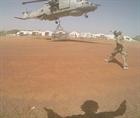Culdrose Merlins fly over 10,000 miles in fight against Ebola
The Merlins of 820 Naval Air Squadron have covered the length and breadth ofSierra Leone supporting Britain’s efforts on the ground to halt the spread of the Ebola disease.
Using support ship RFA Argus as their base off the capital Freetown, the three helicopters have spent more than nine days in the skies – over 210 hours – delivering supplies, food, stores and people. Among the Merlins’ passengers during their first month in West Africa: Sierra Leone’s President Ernest Bai Koroma, who was flown to remote towns to allow him to spread the message on combating Ebola.
The 14-tonne helicopters, based at Royal Naval Air Station Culdrose are normally used for hunting down submarines, pirate and drug-runners. But for their latest mission in Sierra Leone, codenamed Operation Gritrock, the helicopters have been stripped of their anti-submarine hardware and being used to deliver desperately-needed aid in huge under slung nets that can hold several tonnes.
In addition to the Ebola mission, the three helicopters have been flying supplies for the United Nations’ World Food Programme into the mountains in the heart of Sierra Leone – a mission which was a few hours for the Merlins, but would have taken vehicles on the ground two days.
“The squadron is really delivering everything asked of us,” said Commander Ross Spooner, 820 Squadron’s Commanding Officer. “The response from the people of Sierra Leone continues to amaze, with the aircraft generating huge crowds wherever we land. The focus and commitment of personnel and many non-government organisation, who are on the front-line of the fight against Ebola in remote and isolated sites is extremely humbling and fully deserving of all the support we can provide. The challenge now is to sustain the significant effort to ensure we sustain the incredibly positive impact achieved so far.”
Temperatures in Argus’ hangar have been nudging40°C – and with humidity at 95 per cent, 820’s engineers have been pushing their physical boundaries.
They are working eight-hour shifts, making sure one Merlin is always available for daily duties and another is ready to scramble at 30 minutes’ notice. Aircrew usually fly at least six hours in the heat every day they are on duty – but it can rise to eight in the event of a particularly important or pressing mission.
“The aircraft themselves also suffer in the heat – the gas turbine engines do not give as much power, and the rotor blades do not generate as much lift in hot conditions as they do in cold,” explained Aircrewman WO1 Jay O’Donnell. “It means the helicopters cannot lift as much weight – stores, people or fuel.”
To get around the problem, the squadron’s engineers have stripped the Merlins down to the bare bones, whilst making sure the helicopters can still safely operate in and out of the landing sites and confined areas which they need to visit.
The bulk of the Merlins’ three-dozen sorties to date have been flying to theUK’s forward operating bases and treatment units established aroundSierra Leone.
Six Ebola treatment centres are being set up by the UK with the goal of providing beds for more than 700 patients and medical care to around 8,800 people over six months.





